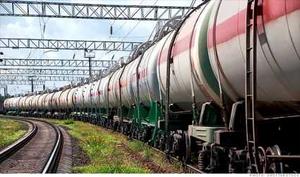Rail securityMore crude oil shipments by rail mean more accidents, but security measures lag
American rail companies have long operated under federal laws, making it difficult for local officials to gather information on cargo and how rail companies select their routes. An increase in the number of trains transporting crude oil, accompanied by a series of derailments and explosions, has highlighted the dangers of transporting hazardous substances by rail.In February, the Department of Transportation announced that railroads had voluntarily agreed to apply the same routing rules to oil trains that they currently apply to other hazardous materials. Critics say more needs to be done.

Tanker cars part of a long line of oil-bearing rail cars // Source: cnyes.com
American rail companies have long operated under federal laws, making it difficult for local officials to gather information on cargo and how rail companies select their routes. An increase in the number of trains transporting crude oil, accompanied by a series of derailments and explosions, has highlighted the dangers of transporting hazardous substances by rail.
Earlier this year, federal regulators warned that crude oil transported by rail from the Bakken region in North Dakota can explode in an accident. This is what happened in July 2013, when a runaway crude oil-carrying train derailed and blew up, killing forty-seven people in Canada, just ten miles from the border with the United States.
Railroads are exempted from federal “right to know” regulations of hazardous materials, so local authorities are provided little information when hazardous chemical incidents occur. State legislatures in Washington and Minnesota have passed resolutions seeking more information from railroads companies.
According to the New York Times, railroads review twenty-seven factors before they select routes for hazardous shipments. They use a Rail Corridor Risk Management System, which examines tens of thousands of routes on an annual basis. The twenty-seven factors include distance traveled, the number of grade crossings, the proximity of “iconic targets” along the way, and the threat of terrorism.
The management system used to select routes is a public-private partnership, but little transparency is offered to local officials. Gary T. Sease, a spokesman for CSX, said the system’s analysis “are considered sensitive security information, and we are not able to share details.”
Fred Miller, a rail consultant, noted that the system has yet to prove its effectiveness in reducing shipping hazards by avoiding populated areas. “The federal government has produced not one line of public assessment on the effectiveness of the law in reducing risk,” he said.
The National Transportation Safety Board has recommended that railroads “avoid populated and other sensitive areas” when shipping hazardous materials. In February, the Department of Transportation announced that railroads had voluntarily agreed to apply the same routing rules to oil trains that they currently apply to other hazardous materials. The agreement, which will become effective in July, and includes other commitments like reducing speed limits to forty miles per hour in large metropolitan areas, and providing $5 million to develop training programs for emergency responders.
The surge in oil transported by rail has reached roughly 784,000 barrels a day, or 11 percent of domestic production, and the Association of American Railroads expects the trend to grow. Railroad officials say tighter regulations could harm private investments made to upgrade tracks and rail safety.
Critics say the federal government has been weak on addressing rail safety. “There is an unwillingness to use any kind of enforcement power at the federal level,” said Mike O’Brien, a Seattle City Council member who sponsored a resolution seeking greater disclosures from the industry. “The railroads have a lot of protections through federal statutes. That’s the ongoing challenge we face as cities.”
